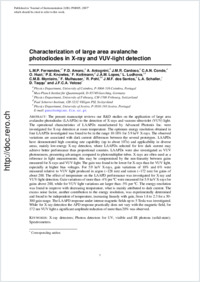Characterization of large area avalanche photodiodes in X-ray and VUV-light detection
- Fernandes, L. M. P. Physics Department, University of Coimbra, , Portugal
- Amaro, F. D. Physics Department, University of Coimbra, , Portugal
- Antognini, A. Max-Planck Institut für Quantenoptik, Garching, Germany
- Cardoso, J. M. R. Physics Department, University of Coimbra, , Portugal
- Conde, C. A. N. Physics Department, University of Coimbra, , Portugal
- Huot, Olivier Physics Department, University of Fribourg, Switzerland
- Knowles, Paul E. Physics Department, University of Fribourg, Switzerland
- Kottmann, F. Paul Scherrer Institute, Villigen, Switzerland
- Lopes, J. A. M. Physics Department, University of Coimbra, , Portugal
- Ludhova, Livia Physics Department, University of Fribourg, Switzerland - Paul Scherrer Institute, Villigen, Switzerland
- Monteiro, C. M. B. Physics Department, University of Coimbra, , Portugal
- Mulhauser, Françoise Physics Department, University of Fribourg, Switzerland
- Pohl, R. Max-Planck Institut für Quantenoptik, Garching, Germany - Paul Scherrer Institute, Villigen, Switzerland
- Santos, J. M. F. dos Physics Department, University of Coimbra, , Portugal
- Schaller, Lukas A. Physics Department, University of Fribourg, Switzerland
- Taqqu, D. Paul Scherrer Institute, Villigen, Switzerland
- Veloso, J. F. C. A. Physics Department, University of Aveiro, Portugal
-
17.08.2007
Published in:
- Journal of Instrumentation. - 2007, vol. 2, no. 08, p. P08005
English
The present manuscript reviews our R+D studies on the application of large area avalanche photodiodes (LAAPDs) to the detection of X-rays and vacuum ultraviolet (VUV) light. The operational characteristics of LAAPDs manufactured by Advanced Photonix Inc. were investigated for X-ray detection at room temperature. The optimum energy resolution obtained in four LAAPDs investigated was found to be in the range 10-18% for 5.9 keV X-rays. The observed variations are associated with dark current differences between the several prototypes. LAAPDs have demonstrated high counting rate capability (up to about 10⁵/s) and applicability in diverse areas, mainly low-energy X-ray detection, where LAAPDs selected for low dark current may achieve better performance than proportional counters. LAAPDs were also investigated as VUV photosensors, presenting advantages compared to photomultiplier tubes. X-rays are often used as a reference in light measurements; this may be compromised by the non-linearity between gains measured for X-rays and VUV-light. The gain was found to be lower for X-rays than for VUV light, especially at higher bias voltages. For 5.9 keV X-rays, gain variations of 10% and 6% were measured relative to VUV light produced in argon ( ∼ 128 nm) and xenon ( ∼ 172 nm) for gains of about 200. The effect of temperature on the LAAPD performance was investigated for X-ray and VUV-light detection. Gain variations of more than -4% per oC were measured for 5.9 keV X-rays for gains above 200, while for VUV light variations are larger than -5% per oC. The energy resolution was found to improve with decreasing temperature, what is mainly attributed to dark current. The excess noise factor, another contribution to the energy resolution, was experimentally determined and found to be independent of temperature, increasing linearly with gain, from 1.8 to 2.3 for a 50-300 gain range. The LAAPD response under intense magnetic fields up to 5 Tesla was investigated. While for X-ray detection the APD response practically does not vary with the magnetic field, for 172 nm VUV light a significant amplitude reduction of more than 20% was observed.
- Faculty
- Faculté des sciences et de médecine
- Department
- Département de Physique
- Language
-
- English
- Classification
- Physics
- License
- License undefined
- Identifiers
-
- RERO DOC 8330
- DOI 10.1088/1748-0221/2/08/P08005
- Persistent URL
- https://folia.unifr.ch/unifr/documents/300479
Statistics
Document views: 117
File downloads:
- schaller_cla.pdf: 143
